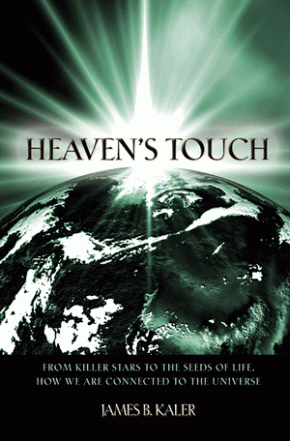Learning how we connect with the universe is one of the most fruitful investigations of modern science. No matter how we approach the matter, we’re confronted with interesting possibilities. We study how gas giant planets may affect life on inner, terrestrial worlds by diverting asteroids from potential impacts. We look at issues like panspermia, wondering whether life’s building blocks (or even life itself) arrived from elsewhere in the cosmos.

In recent times, we’ve examined our Solar System’s movements through the galaxy to ask whether there may be clues to periodic mass extinctions on our planet. As we widen stellar habitable zones into galactic ones, our musings take us out into the universe. They also confront us with our own limitations — our eyes, notes astronomer James Kaler, see wavelengths between 0.00004 and 0.00008 of a centimeter. Kaler calls our visual spectrum “…but one octave on an imaginary electromagnetic piano with a keyboard hundreds of kilometers long.”
That imaginative expansion of scale is what Kaler (University of Illinois, Urbana-Champaign) sets about exploring in his new book Heaven’s Touch: From Killer Stars to the Seeds of Life, How We Are Connected to the Universe (Princeton, 2009). He’s interested in everything from lunar and solar tides to solar storms that can knock out power grids on Earth, and he moves readily through the effects of a nearby supernova to hot-button issues like climate change. He’s a clear writer who consolidates rather than surprises, attempting to pull together our current theories on what we see, and what we don’t.
Here, for example, is a brief take on dark matter:
Our Galaxy, its stars revolving around the center under the influence of their combined gravity, is spinning too fast for what we see. Galaxies in clusters orbit around the cluster’s centers under the influence of their mutual gravities, but again, they move faster than expected. There must be something out there with enough of a gravitational hold to do the job, to speed things up, but it is completely unseen. Dark matter. It surrounds galaxies, pervades their clusters. We have no idea what constitutes it. Rather, there are many ideas, but none that can be proven. Add it all up based on the amount of mass needed to yield dark matter’s gravity, and lo, one finds another 20 percent, getting us up (once the numbers are rounded off) to a quarter of that required to unfold the Universe, but still not enough.
The passage moves on to an examination of dark energy. I quote this paragraph on dark matter because we’ve been discussing the possibilities in recent comments here on Centauri Dreams, but as Kaler notes, we’re a long way from knowing what makes up dark matter and some theories still reject it altogether. Any consistent theory must square both those anomalous galactic rotations and the evidence from gravitational lensing around galactic clusters, a challenge laid out in more fine-grained detail in Evalyn Gates’ superb Einstein’s Telescope (W.W. Norton, 2009).
In any case, I haven’t finished the book, so I’ll post more on Heaven’s Touch as I push farther into it. I’m not finding anything that would startle Centauri Dreams readers but because I admire Kaler’s clarity, I’m hoping this volume will strike a chord with the broader public, one for whom otherwise esoteric topics like the shielding effects of the solar heliopause on our system will awaken an interest in our planet as a celestial wanderer, a member of a system that is itself moving through a medium we only partially understand, one that has affected everything that we are and do.



Naked-eye and binocular astronomy has always connected me by perspective. I look at the daytime sky and clouds from the bottom of the ocean of atmosphere, with its fluid movements. The dome of Earth’s shadow is seen in the atmosphere before sunrise or after sunset as it moves, showing the shape of our world. Nightly and weekly motion of the planets near the ecliptic are seen to move within a disc with the inferior planets distinct from the superior. I position the sun which is beneath my horizon. This temporal view is kind of like watching a squash grow, returning to notice the changes. This disc around Sol with the galactic background is a vista, the cosmic scenery we are within.
This time of year is wonderful for aiming good-aperture binoculars toward Perseus and Cassiopeia. The nearer stars and stellar associations, with the backdrop of the Perseus Arm with distinct stars and star clouds give a kind of third dimensional view to our galaxy. ‘Strings’ of stars give the impression of a group with a common origin, moving with a whip-like shape.
And while looking at this in awe, I think of the possibilities of other worlds with life, and intelligence, with curiosity and perhaps entelechy. I remember Carl Sagan’s words: The Earth, and every living thing, are made of star-stuff.
Here is the Princeton University Press Web site on Heaven’s Touch,
which includes the Table of Contents and Chapter 1 in PDF format:
http://press.princeton.edu/titles/8991.html
Our planet is indeed well connected with larger cosmic events but this fact is not very noticeable to individuals because most, though not all, of these heavenly happenings occur on timescales that dwarf a human lifetime. It could be a long long time before a supernova explodes that would be capable of adversely affecting life on Earth. To really experience the cosmic events it will be necessary for humans to become present in a variety of locartions around the Universe. One of things I regret most in life is that even though I am reasonably young, in all probably I will not live to be a part of humanity’s moving out into the Universe in a big way:(